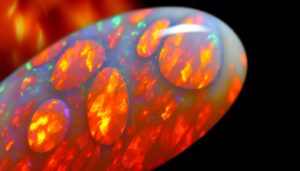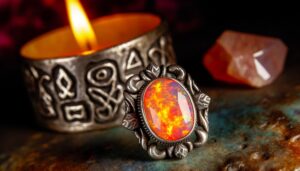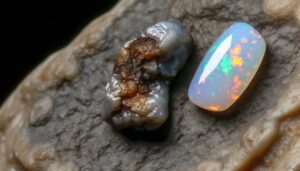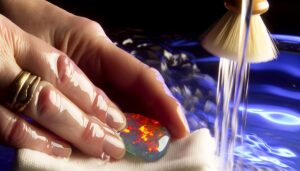How Is a Glass Fire Opal Defined?
You'll find that a glass fire opal is a spellbinding gemstone, formed when silica-rich lava rapidly cools in volcanic regions. This process prevents a crystalline structure, resulting in a glass-like appearance.
These opals exhibit vibrant hues, from fiery reds and oranges influenced by iron oxides to subtle greens introduced by chromium and nickel. Transparency levels range from opaque to highly translucent, affected by inclusions like gas bubbles and dendritic patterns.
Despite their fragile nature, glass fire opals are prized for their unique optical properties and affordability. Learn more about their formation and characteristics that make them so distinctive.
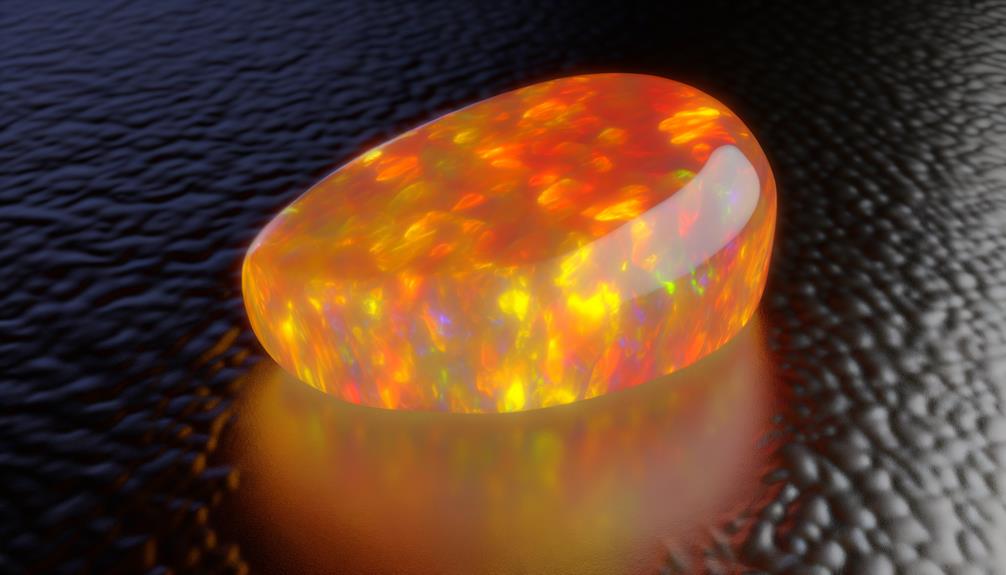
Key Takeaways
- Formed from rapid cooling of silica-rich lava in volcanic regions, resulting in hydrated amorphous silica.
- Known for vivid colors ranging from fiery reds and oranges to subtle yellows and greens.
- Transparency varies from opaque to highly translucent, influencing light play and color intensity.
- Unique inclusions like dendritic patterns, gas bubbles, and mineral specks add visual interest and authenticity.
- Lower durability with susceptibility to scratches and chipping, but generally affordable and accessible.
Origins of Glass Fire Opals
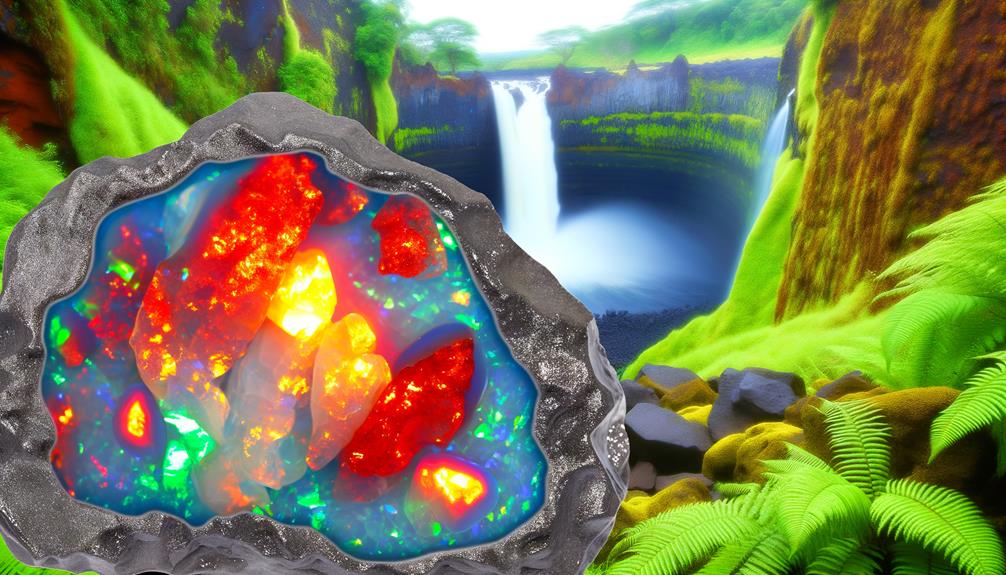
Glass fire opals, primarily sourced from volcanic regions, form through rapid cooling of silica-rich lava. When a volcano erupts, the lava expelled contains high concentrations of silicon dioxide. As this lava quickly cools and solidifies, it traps water and other volatile compounds, creating a hydrated amorphous form of silica.
You'll find that this rapid cooling process prevents the formation of a crystalline structure, resulting in the opal's glass-like appearance. The presence of various trace elements can influence the coloration and transparency of the opal. Understanding these geological processes helps you appreciate the unique conditions required for glass fire opals to form.
Therefore, the origins of glass fire opals are intrinsically linked to volcanic activity and rapid silica solidification.
Key Characteristics
When examining Glass Fire Opals, you'll notice their color variations range from vivid oranges to deep reds, indicative of their silica content.
Assess their transparency levels, as these can fluctuate from completely transparent to semi-translucent, affecting their visual appeal and valuation.
Additionally, unique inclusions within the opal matrix can provide insights into formation conditions and contribute to the gemstone's overall uniqueness.
Color Variations
Among the myriad color variations, the key characteristics of glass fire opal include its vibrant hues ranging from fiery reds and oranges to subtle yellows and greens, each determined by trace elements and the stone's unique structure.
The presence of iron oxides often results in red and orange tones, while traces of chromium and nickel can introduce greenish tints. The stone's amorphous silica composition allows for light diffraction, enhancing its brilliance.
You'll notice that the intensity of coloration can vary significantly, influenced by the opal's internal microstructure. This play-of-color phenomenon, known as opalescence, is a hallmark of glass fire opals, contributing to their desirability and market value.
Understanding these variations aids in precise appraisal and selection.
Transparency Levels
Transparency levels in glass fire opal range from completely opaque to highly translucent, greatly impacting their optical properties and valuation. You'll find that the degree of transparency affects light play, brilliance, and color intensity, which are critical for gemologists and collectors. Here's a concise table to illustrate the varying transparency levels and their associated characteristics:
| Transparency Level | Characteristics |
|---|---|
| Opaque | No light transmission |
| Semi-opaque | Minimal light transmission |
| Semi-translucent | Moderate light diffusion |
| Translucent | Significant light passage |
| Highly translucent | Maximum light passage, vibrant color |
Understanding these transparency levels helps you assess the gem's quality and potential application. For instance, highly translucent opals often fetch higher market prices due to their enhanced visual appeal.
Unique Inclusions
Inclusions within glass fire opal, such as dendritic patterns, mineral specks, and gas bubbles, serve as distinctive markers that influence both its aesthetic qualities and gemological examination.
Dendritic inclusions, often resembling tree-like structures, provide a unique visual appeal, making each stone one-of-a-kind.
Mineral specks, usually composed of iron or manganese, contribute to the stone's color variations and overall appearance.
Gas bubbles, trapped during the formation process, add to the opal's internal complexity and can affect its transparency.
These inclusions aren't merely imperfections; they're essential for evaluating the stone's authenticity and value.
Color Variations
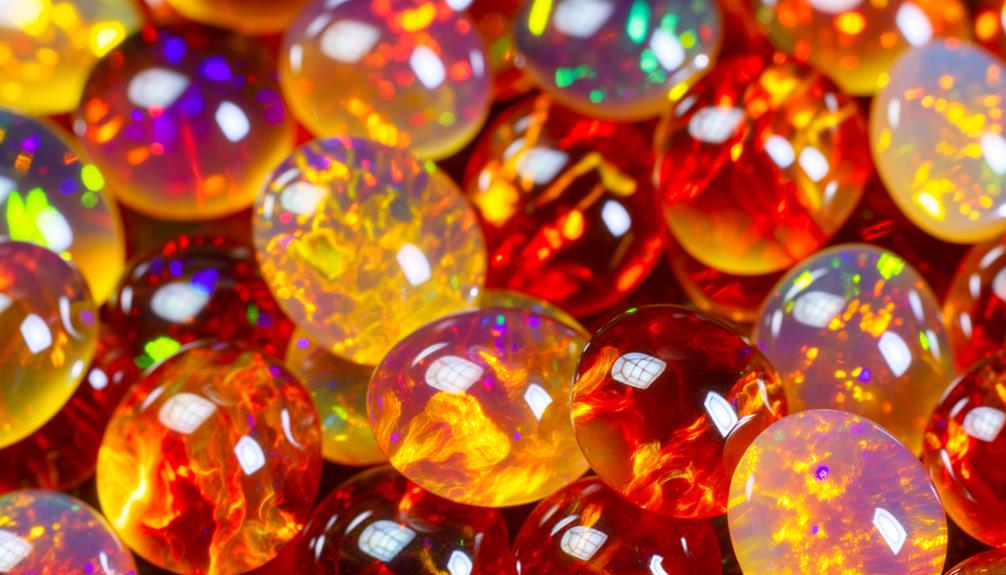
When examining Glass Fire Opal, you'll observe a wide spectrum of hues ranging from vivid reds to subtle yellows.
The color intensity primarily hinges on trace element composition and the uniformity of the silica spheres within the opal matrix.
Variations in these factors greatly influence the gemstone's visual appeal and market value.
Spectrum of Hues
The spectrum of hues in glass fire opal encompasses a breathtaking array of vibrant colors. From fiery reds and oranges to subtle yellows and delicate pinks, each color results from specific trace elements and structural variations. These colors arise from the interplay of light with the silica spheres within the opal, which diffract light into its constituent wavelengths.
The presence of iron oxide can induce reddish tones, while nickel and manganese contribute to yellow and pink hues, respectively.
Understanding these color variations allows you to appreciate the complex chemistry behind each vibrant hue.
Color Intensity Factors
To appreciate the color intensity in glass fire opal, you'll need to take into account factors like the size and density of silica spheres, the angle of light incidence, and the concentration of trace elements.
The silica spheres' uniformity and arrangement determine the diffraction of light, influencing the opal's vibrant play-of-color. Variations in sphere size can shift the visible spectrum, altering hues.
The angle of light incidence affects how light interacts with these spheres, creating dynamic color shifts. Trace elements like iron or magnesium can introduce additional color variations, enhancing the opal's overall intensity.
Production Process
Crafting glass fire opal involves a meticulous process of selecting high-quality silica-based materials and employing controlled heating techniques to achieve the desired optical properties.
You'll start by choosing pure silica and mixing it with specific metal oxides to introduce vibrant color variations.
Next, you must carefully manage the temperature in a furnace to guarantee uniform melting and avoid crystallization, which could compromise the stone's optical clarity.
Critical steps include:
- Controlled Cooling: Gradually reduce the temperature to prevent internal stress within the glass.
- Annealing: Maintain a stable temperature to release residual stress and enhance durability.
- Polishing: Precisely shape and smooth the glass to maximize light refraction and achieve a high-quality finish.
Understanding these steps guarantees you produce a superior glass fire opal.
Uses in Jewelry
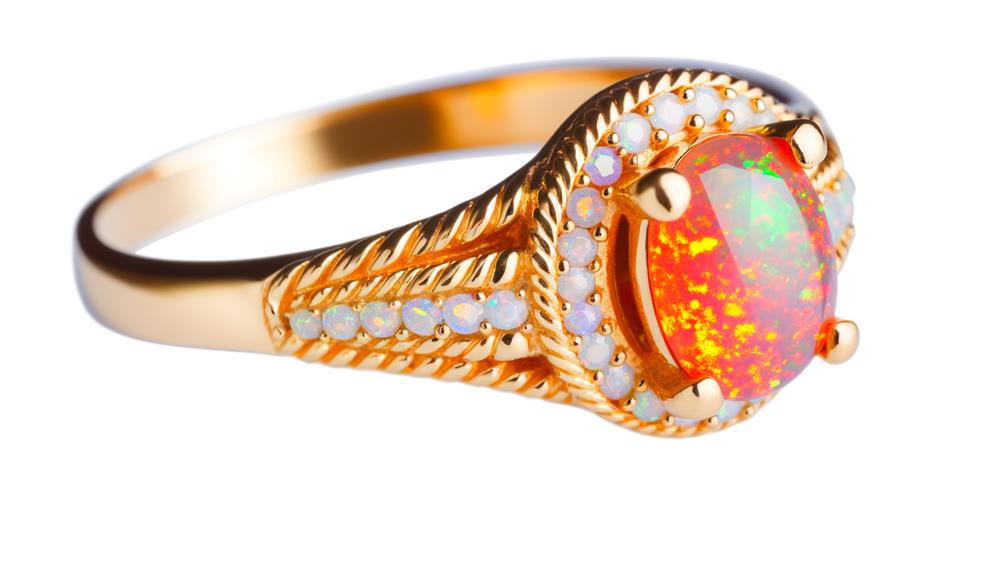
Once you've mastered the production process, you can explore the diverse applications of glass fire opal in jewelry design. Glass fire opal's unique refractive index and vivid coloration make it ideal for various settings, from rings to pendants.
You can utilize bezel settings to securely encase the opal, enhancing its visual appeal and durability. Prong settings, on the other hand, allow more light to interact with the stone, amplifying its fiery brilliance.
Additionally, integrating glass fire opal into multi-gemstone pieces can create striking contrasts and harmonious color schemes. Consider the opal's hardness and stability when designing intricate pieces, ensuring longevity.
Employing these strategies, you'll craft exquisite jewelry that showcases glass fire opal's enticing allure.
Benefits and Drawbacks
Evaluating the benefits and drawbacks of glass fire opal requires a careful analysis of its optical properties, durability, and cost-effectiveness.
Glass fire opal offers vibrant color play and high refractive index, mimicking natural opals effectively. However, its durability is lower compared to natural stones, making it prone to scratches and chipping.
Cost-wise, glass fire opal is more affordable, providing a cost-effective alternative for jewelry enthusiasts.
Key aspects to examine:
- Optical Properties: High refractive index and color versatility.
- Durability: Lower resistance to physical wear and tear.
- Cost-Effectiveness: Affordable and accessible, especially for budget-conscious consumers.
Understanding these factors helps you make an informed choice about incorporating glass fire opal into your jewelry collection.
Conclusion
As you explore deeper into the world of glass fire opals, imagine the myriad possibilities these gems hold. Their unique origins, vibrant color variations, and intricate production process make them an irresistible choice for jewelry.
But, will their benefits outweigh the drawbacks? With their unparalleled beauty and technical precision, glass fire opals might just be the next game-changer in gemstone innovation. Are you ready to uncover their full potential?
The journey has only just begun.



